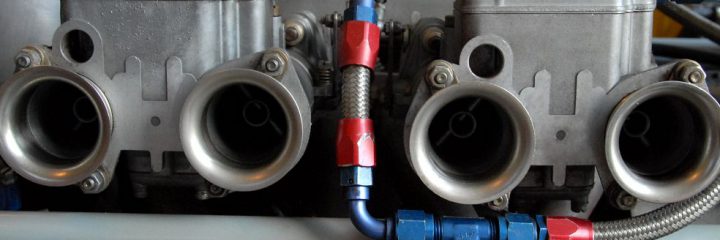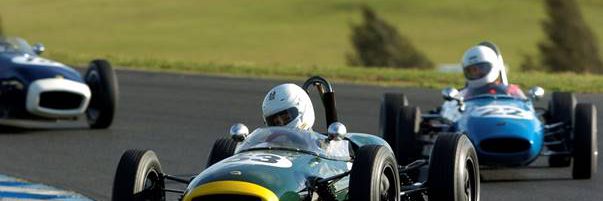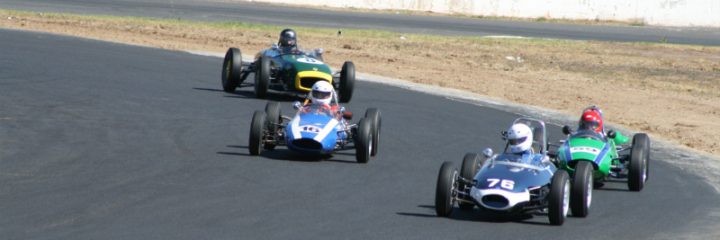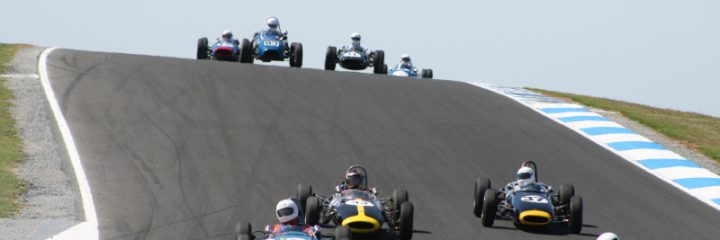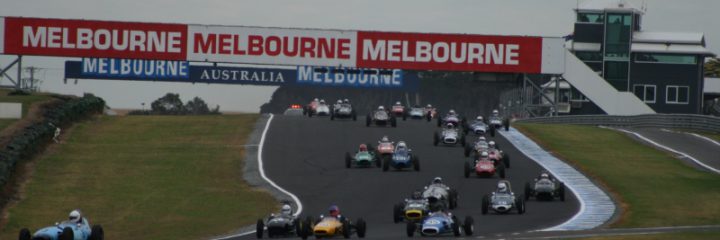Qualifications
The qualifications for an Australian Historic Formula Junior racing car shall require the vehicle to have been raced as a Formula Junior under 1100 cc during the period ending 31st December 1963. These cars together with invited cars, which are similar, but from outside the period may compete as Historic Formula Juniors PROVIDED the car complies with the original FIA regulations for Formula Junior and Motorsport Australia 5th category current regulations.
From 2007 all cars contesting the AFJA Annual Trophy Series shall be required to use the FIA control tyre as provided for in Motorsport Australia (formerly CAMS) schedule E part 4, namely Dunlop “L” section tyres with 204 compound and the appropriate recommended size for 13″ wheels being 4.50 front and 5.50 rear, and for 15″ wheels 4.50 front and 5.00 rear.
To qualify for historic racing in Australia, a Formula Junior is required to have a current historic log book and certificate of description issued by either the F.I.A or Motorsport Australia, or a temporary permit for given events.
At any event entered the car must pass both safety and eligibility tests by scrutineers at the circuit to qualify. This may include weighing the vehicle and checking engine capacity.
Current 5th Category Regulations
Cars are required to have established a racing history in the relevant group period. Subject to the permitted modifications listed below and the addition of required safety equipment, cars must be in the original specification for the particular vehicle at a single point of time within the group period.
Modifications Allowed
ENGINE
- Cylinder bore may be increased to a maximum of 1.5 mm from original size in period.
- Crankshaft stroke must be original
- Cylinder block/crankcase must be original
- Internal components of engine are free except for roller rockers which are illegal
- From 2011 recast Richardson Ford Anglia cylinder heads may be used on group M post 1960 cars
INDUCTION
- Inlet manifolds are free, but carburettors must be of the period make, type and number fitted to vehicle, however, the size may be altered.
TRANSMISSION
- Casings must be original and contain original number of forward ratios, otherwise, internal components are free.
- 40HP VW transmissions are an acceptable replacement for 36HP split case units
CHASSIS / SUPENSION
- The chassis must be original and unmodified from period specifications except for limited local stiffening. The suspension shall remain unaltered from period specifications, except that spring rates, ride height and damper settings are free.
BRAKES
- The braking system shall be the same type and size as fitted in the period. Drum brakes may be replaced with others of period type, and cooling devices may be added.
WHEELS AND TYRES
- Wheels must be original in diameter, width, style and appearance. Cast wheels may employ different material provided dimensions and appearance remain unaltered.
- From 2007 all cars competing in the AFJA annual trophy series will use the FIA control tyre as provided for in Motorsport Austalia schedule E part 4 , namely, Dunlop “L” section tyres with 204 compound. The appropriate recommended size for 13″ wheels being 4-:50 front and 5 :50 rear, and for 15″ wheels 4 :50 front and 5 : 00 rear.
ELECTRICAL EQUIPMENT
- From 2006 all cars will require a “Dorian” electronic timing device to be fitted, whilst all other electrical equipment must remain unaltered from period specification including the use of any form of electronic ignition. It is however permitted to use a non performance enhancing form of electronic rev limiter.
SAFETY EQUIPMENT (VEHICLE)
- In addition to original equipment retained, all vehicles are exempt from requirements to install fire extinguishing systems, scatter shields, towing eyes, fire walls and safety fuel tanks, however, the following equipment is required and must comply with Motorsport Australia regulations
- Oil breather catch tank
- Driver operated battery isolation switch
- Roll bar conforming to current specifications
- Drivers safety harness
- All tanks with quick release filler cap shall have secondary locking device, or be wired shut.
- Whilst not compulsory the use of a rain light is recommended
Federation Internationale De L’Automobile Regulations for the “Junior” Racing formula
Article 1: Definition
Cars of the “Junior” formula are one-seater racing cars, whereof the fundamental elements are derived from a touring car recognised as such by the F.I.A. (minimum production 1,000 units in 12 consecutive months)
Article 2: General characteristics
- minimum wheelbase : 200cm
- minimum track : 110cm
- maximum width of body : 95cm (measured outside)
- maximum engine cylinder capacity : 1,100cc
- minimum weight : 400kgs
The latter weight limit, however, is reduced to 360kgs for cars with a cylinder-capacity of 1,000cc or less. the above mentioned weight shall be measured with the car “in running order”, viz. without ballast, and with all accessories required by these regulations but with dry fuel tank(s). The ballast which is prohibited is that of a removable type. It is, therefore, permissible to complete the weight of the car through one or several ballasts incorporated to the materials of the car, provided that solid and unitary blocks are used, and that they are fixed by means of a tool and offer the opportunity of being sealed on, should the officers entrusted with scrutineering deem it necessary.
Article 3: Mechanical elements
- the cylinder block, including the cylinder head and cylinders (if the latter are removable) must be those of the engine belonging to a car classed by the F.I.A. in the Touring category.
- the gear-box must be that of an F.I.A. recognised touring car. Complete freedom is left with regard to the number and staging of gear ratios
- the system and principle of feeding (by carburettor or by injection) must be the same as on the car from which is taken the engine
- the cylinder capacities specified in the present regulations may be achieved by modifying the original bore (increase or reduction). No modification of the stroke is permitted.
- the car must have an automatic starter.
- the braking system shall be such that the pedal normally controls four wheels, and in the event of failure of any one part the pedal shall still control at least two wheels of one same axle. For cars constructed before 1962: the braking system and principle (viz. drum-brakes or disc-brakes) must remain the same as on the car from which is taken the engine
Article 4: Body
The body, open and offering only one seat, shall comprise, around the pilot’s seat, an anti-roll bar, protecting him from being crushed should the car turn over. There shall also be a protective device against fire as required by the International Sporting Code (Art. 125)
Article 5: Silencer
The supplementary Regulations of the events may provide that an efficient silencer is compulsory.
Article 6: Prohibitions
It is not permitted:
- to use an engine with one or more overhead camshafts
- to use a self-locking differential
- to change the number of crankshaft bearings
- to change the location of the camshaft
Article 7: Fuel
Only commercial fuel, as defined by the F.I.A. shall be used
FIA International Racing Formula 3
as described in 1964 CAMS manual
The original FIA rules governing this formula are identical with the Formula Junior rules, as illustrated above, except for the following variations
- The maximum cylinder capacity of 1000cc may be achieved by modifying bore and or stroke dimensions
- The gearbox is limited to 4 forward gears, and must have a reverse gear
- The engine is limited to 1 carburettor with a 3mm thick, 36mm restrictor mounted between its flange and the intake manifold













